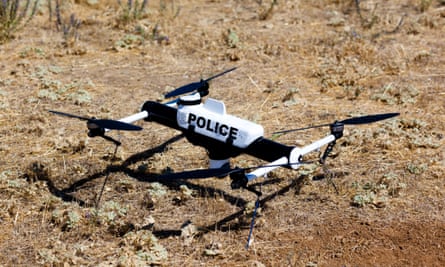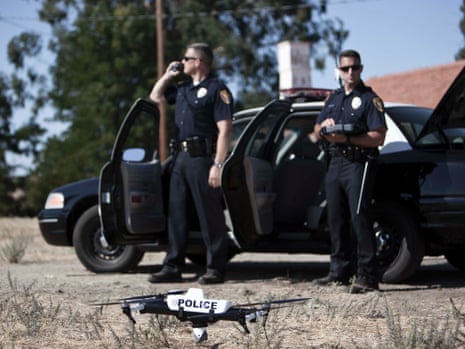The video begins with a suspect in a red car screeching to a halt outside an abandoned farmhouse with two police vehicles, sirens blazing, in hot pursuit. The suspect makes off on foot, waving a large handgun in front of him.
Then something unusual happens. Out of the back of a police car, officers grab a gadget about the size of a suitcase, assemble it within seconds and then launch it buzzing into the air. It hovers directly over the suspect, streaming images of the man from a high-definition camera down to a mobile computer screen. “I have a visual of the suspect,” an officer says into his radio device. “Positive ID of a gun in his right hand – proceed with caution.”
The film is an elaborate piece of theatre, replete with hard-rock soundtrack, designed to show off the law enforcement potential of the Qube, an unmanned aerial vehicle (UAV). The gadget – which has four rotor blades, is three feet long and weighs 5.5lbs – is at the forefront of the use of drone technology by police forces in the US.
Among the early adopters experimenting with drones is the Grand Forks sheriff’s department in North Dakota. It now has a fleet of four UAVs, including a Qube, another quadrotor called a Draganflyer, and a fixed-wing Raven.
That puts Grand Forks, a town of just 50,000 people close to the Canadian border, in the thick of one of the most hotly contested questions in modern policing – whether drones are a powerful way to improve public safety or a threat to individual privacy. Few places are as far advanced in addressing the issue as Grand Forks – so far, only about a dozen police departments across the US are thought to be fully equipped and trained to use the aircraft, and Grand Forks was the first in the nation to be given federal approval to fly at night.
“We see ourselves as the vanguard of the safe use of small UAVs for law enforcement,” said deputy sheriff Alan Frazier.
Since the local department began testing drones about 18 months ago, it has flown 11 active missions with the unmanned aircraft. None of them, it must be said, was anything like as dramatic as the scene in the Qube publicity video.
Five of them involved putting a drone up over a crime or traffic accident scene to take digital photographs that might provide detectives with useful intelligence from an aerial perspective. Two of the missions were related to the threat of flooding from the Red river, which is an annual hazard in the region. A further three of the events were searches for missing people – two victims of drowning and the third a person concussed in a car crash who wandered away from the scene in a daze.
Of the remaining two missions, one involved a search for two suspected criminals who had escaped from a local jail. It was thought that the men were hiding out in one of the giant fields that fill this part of the northern Great Plains.
The field was covered in corn stalks rising seven or eight feet high that made visibility on the ground impossible, and it would have taken a Swat team many hours to search it on foot. So instead they launched over the field a Qube fitted out with a thermal-imaging device that could detect any live presence through body heat. The field was quickly traversed, and found to be empty – though the suspects were not there, the automated search freed up police officers to look elsewhere and the suspects were soon picked up in the surrounding area.
The final mission came in an investigation into the rape of two students in their college apartment. Sheriffs wanted to test out a theory that the suspect had stalked his victims for some time, so they flew a drone outside the window of his apartment to show that he had a clear line of sight to the women’s premises. The footage, taken by high-definition camera, was of high-enough quality that it could be presented in court as forensic evidence.
Frazier is a proselytizer for law enforcement drones. He believes they add to the police officer’s toolkit in fighting crime. He also stressed how cheap they are to run – when he worked with manned police helicopters in his previous job in Glendale, southern California, the unit cost $12m a year to sustain, while his current drone unit in Grand Forks costs just $10,000 annually.
As interest in drones has grown among police agencies, so too have fears about the downsides. Debates have raged across the country about whether the technology could lead to a vast expansion of police surveillance on individuals.
Such concerns have been fueled by plans floated by police departments for blanket surveillance. The city of Ogden, Utah, came in for a lot of criticism when it proposed putting a blimp semi-permanently on patrol.

At a recent police trade show in Oakland, California, called Urban Shield, drone companies were marketing UAVs equipped with high-definition cameras. One firm, HaloDrop, said it was developing software that would facilitate the filming of a face from as much as 300 meters away, using stabilised imaging that could then be passed through police face recognition databases.
Debates around the appropriate limits to police drones have in turn led to legislative action. In the most recent and high-profile case, the California legislature passed a new law that would impose a strict requirement on all law enforcers that they must acquire warrants before launching drones in all but emergency situations.
Jay Stanley, an expert on technology-related privacy issues at the American Civil Liberties Union, said that so far the small number of police forces that have adopted drones appear to be using them in relatively sensible and cautious ways. But he warned against complacency about the future.
“Whenever there’s a powerful new technology – license plate readers are a good example – the police vigorously adopt it. And they often try to keep it secret,” Stanley said.
“We are in the very early days here. The current baby steps the police are taking to use drones will be replaced by a much broader use if we don’t act first to put in place commonsense regulations.”
Frazier believes that the privacy fears around police drones are overblown. He thinks media sensationalism, coupled with public confusion about military drones, has given civilian unmanned aircraft a bad name.
“There’s been a lot of misnomers about these craft as covert spy tools. ‘Drone’ has become a negative term. We don’t use them covertly at all – we only use them for events that are totally overt or where individuals have no grounds for privacy such as those two fugitives hiding out in a corn field.”
But some aspects of the arrangements in Grand Forks might give civil liberties advocates grounds for concern. Asked how long the police stored images and other data gathered by its fleet of drones, Frazier gave the vague reply: “We keep it as long as an investigation is ongoing”.
He said that in his experience the experiment with police drones has been enthusiastically received by the public. The contention is borne out by research conducted by the state’s Unmanned Aerial Systems Research Compliance Committee, which was set up two years ago specifically to set ethical and privacy boundaries on drone research in North Dakota as part of the creation of the country’s first official drone test site.
The committee has carried out its own opinion survey of people living in the north-east of the state and found that most citizens are strikingly relaxed about the idea of unmanned police drones buzzing through the famously open skies of North Dakota.
About nine out of ten respondents supported the use of drones in a hostage-taking scenario, a search for missing children or adults, or for disaster response. Similarly overwhelming support was shown for police using drones to hunt for crime suspects or for those illegally crossing the nearby border with Canada or the southern border with Mexico.
Most respondents withdrew their approval of drones, however, when it came to enforcing traffic violations – suggesting that people become flustered about the technology when it could potentially be used against them. In a similar vein, the deployment of police drones to detect illegal hunting or fishing garnered support from only 58% of participants.
“People seem to get less keen on the idea when it gets a little closer to home,” said Thomasine Heitkamp, chair of the compliance committee.
That might explain the paradox that the idea that most upset respondents in the survey was precisely the area that has attracted most interest from big corporations – commercial deliveries to the home. As Google, Amazon, FedEx and many others scramble to develop delivery-by-drone services, the opinion poll made clear people’s wariness about the concept, with 80% opposing alcohol deliveries to the door and 60% saying no to take-out food being dropped by quadcopter.
Packages of the sort that Amazon and FedEx would deliver by drone did somewhat better, with 40% opposition, but that was still greater than the 30% approval rate.
It is arguable how much North Dakota – a solidly conservative state that last voted for a Democratic presidential candidate in 1964 – is representative of the attitude towards drones in the rest of the US. It is unlikely, for instance, that more liberal parts of the country would agree with the 70% of respondents who said they were comfortable with drones being used by the military within US borders.
Heitkamp said she would like to expand the survey to more urban areas on the coast. “Would people respond differently in LA than they did in Langdon, North Dakota?” she said she wondered.
Whether or not North Dakota is out of step with other parts of the US, Frazier plans to carry on developing drones because he is convinced they add a whole new layer of aerial support to officers on the ground. “We made a decision,” he said. “While other agencies sat on the fence, we decided there were no hoops we weren’t going to jump through to make this happen. We persisted.”

Comments (…)
Sign in or create your Guardian account to join the discussion